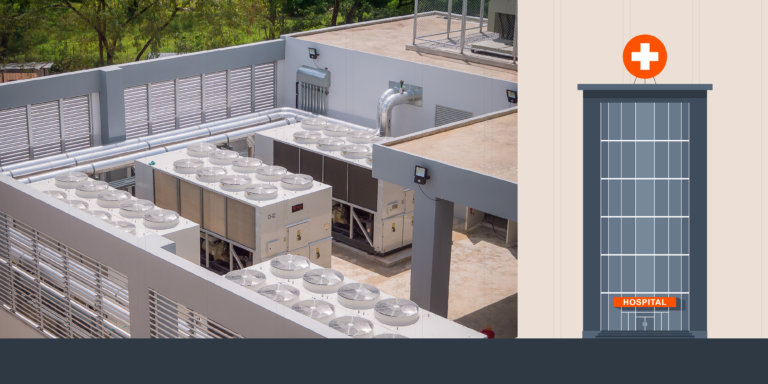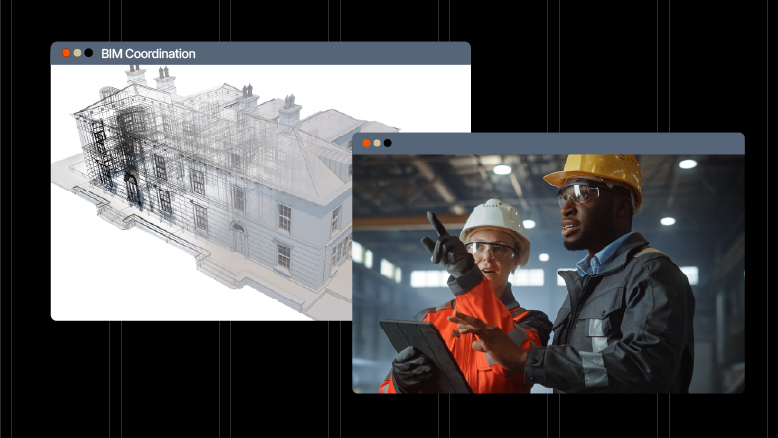— 6 min read
Hospital HVAC Systems: A Guide for Construction Pros
Last Updated Feb 28, 2025
Last Updated Feb 28, 2025

Hospital HVAC (heating, ventilation, and air conditioning) systems provide a safe, comfortable, and controlled environment for patients, staff and visitors. Unlike standard commercial buildings, hospital HVAC systems are integral to infection control and require precise zoning to manage diverse healthcare functions — from patient isolation to the cooling of critical medical equipment. Hospital construction or renovation requires careful consideration of HVAC system needs and placement for project success.
Navigating these complexities successfully requires technical expertise and seamless coordination among general contractors, HVAC specialists, and other trades. This article covers the functions and components of hospital HVAC systems, explores challenges and best practices for construction projects and examines how technological advancements are shaping hospital HVAC systems.
Table of contents
Hospital HVAC System Functions and Components
HVAC is just one component of the complex mechanical, electrical and plumbing (MEP) systems required in hospitals. Along with systems that support and move large medical equipment and medical gas lines, they must integrate with plumbing and electrical needs to create functional structures for advanced medical procedures.
Functions of Hospital HVAC Systems
HVAC serves nuanced purposes in hospital settings, and the types of HVAC in hospitals are often more elaborate and costly than in other construction types.
Air Filtration
High-efficiency particulate air (HEPA) filters remove bacteria, airborne viruses, dust and other particulate from the air.
Ventilation
Fresh air exchange dilutes contaminants and maintains oxygen levels.
Infection Control
Ventilation, filtration and pressurization prevent the spread of airborne pathogens.
Temperature and Humidity Control
Appropriate temperature and humidity levels make patients comfortable, prevent mold growth and keep sensitive medical equipment functional.
Zoning and Airflow Management
Laminar airflow moves air in a consistent pattern and velocity to create a sterile environment in operating rooms. Different air exchange rates and airflow patterns are needed in various other hospital areas.
Pressure Control
Positive pressure helps keep operating rooms sterile. Negative pressure is needed for isolation rooms.
Control Systems
Building Management Systems (BMS) offer integrated control of hospitals' sophisticated environmental and air quality regulation components. They may also monitor fire safety, medical equipment and energy usage.
Hospital HVAC Components
Understanding the primary components of hospital HVAC systems is essential for companies working in healthcare environments. Here are the main parts of the HVAC system to consider:
- Air Handling Units (AHUs)
- Ductwork
- Outdoor Air Intake
- Exhaust Air Ducts
- Filters
- Heating and Cooling Coils
- Dampers
- Monitoring Systems and Sensors
- Control Systems
In addition to HVAC components, other construction aspects significantly influence the performance of the HVAC system. The precise installation of doors and windows, plus making sure ceilings and walls are free from gaps or cracks helps keep rooms airtight for proper HVAC function. Self-closing doors aligned with the airflow direction are another part of maintaining optimal air sealing.
Challenges of Hospital HVAC Systems in Construction
Installing HVAC in hospitals requires close attention to infection control and active communication with stakeholders. The following are some of the most common challenges, along with best practices to mitigate them:
Design Coordination and Spatial Constraints
The extensive MEP, med gas and HVAC systems can easily clash during installation. Fitting extensive HVAC ductwork and equipment into confined spaces without interfering with other systems is a significant challenge. Involving trade contractors during design and preconstruction meetings can minimize problems later on.
Complex Systems Integration
Hospitals require precise coordination of HVAC with other systems, such as electrical, plumbing and medical gas, to ensure functionality. Hospital HVAC systems must be highly reliable, with built-in redundancies for continuous operation, posing additional design and installation challenges. Robust preconstruction planning and using BIM for clash detection can minimize issues on site.
HVAC in hospitals is totally different than just a commercial building. When it comes to BIM, there's a lot more stuff that needs to go in the ceilings and the walls; therefore, coordination is key. If you can get that stuff knocked out ahead of time, you won't have as many issues on the back end during construction. During the preconstruction process, BIM was super important to me in a healthcare setting because there's a lot more to see visually.
Matt Strumeyer
Solutions Engineer
Procore
Regulatory Compliance
HVAC systems must comply with regulations such as the American Society of Health Care Engineering (ASHE) Standard-170, which provides guidance on ventilation requirements for healthcare industry facilities. Federal, state and local authorities regulate the hospital construction process more stringently, and documenting construction and inspections with project management software can help companies prove compliance.
Phased Construction in Active Healthcare Environments
Detailed planning and execution are required to maintain sterile conditions during construction. Concerns include coordinating material deliveries and storage, preventing the spread of airborne contaminants from installation activities, and limiting noise. Teams need to communicate with healthcare providers to minimize disruptions and safeguard patients during construction.
The most intense project I ever did was renovating an operating room. The hospital had three operating rooms, and we were working next to an active operating room. We sealed everything off, extracted the air and started ripping all the drywall out.
We had to relocate the medical gas and shut it down, which needed to work with their schedule so we didn't impact their operations. There are so many things you can do that can have dire consequences.
Dirk Schoenmaker
Project Manager
Halse-Martin Construction
Maintenance and Future-Proofing
Hospitals need to maintain HVAC systems after projects are complete. Future expansions and technological advancements require system designs that can accommodate upgrades without major overhauls. Providing accurate as-built drawings for the facility manager will assist with maintenance and future renovations.
The Role of HVAC in Infection Control and Energy Efficiency
Technology makes it easier to precisely control temperature, humidity and air pressure, which significantly impact infection control in hospital settings. HVAC systems now use the Internet of Things (IoT), with sensors in rooms and equipment sending signals to building management system (BMS) control units to help balance hospital air environments and maintain infection control requirements. Ultraviolet germicidal radiation technology is being used to kill pathogens within HVAC systems and prevent their spread. Computer modeling, like computational fluid dynamics, is improving healthcare HVAC design.
According to a 2023 report by Grumman/Butkus, energy expenses make up half of hospital operational budgets, with HVAC systems being a major contributor to this consumption.
To address these challenges, hospitals are adopting sustainability programs aimed at benefiting people, the environment and the bottom line. Increasingly, they are turning to smart technology to cut energy consumption, utilizing tools like environmental sensors and advanced BMS.
The Preconstruction Playbook
Learn to navigate challenges, understand root causes, and harness technology for smoother project execution. Revolutionize your approach and unlock your team's potential.

Communication and Collaboration for Hospital HVAC Installation
Managing the stringent HVAC requirements in hospital construction involves a high level of communication and collaboration among all project stakeholders. From initial design to final installation, the intricate systems demand precise coordination between contractors, HVAC specialists and healthcare providers.
These strong partnerships allow teams to navigate the unique challenges of healthcare environments, installing HVAC systems that support modern hospitals in delivering safe healthcare to communities.
Was this article helpful?
Thank you for your submission.
0%
0%
You voted that this article was . Was this a mistake? If so, change your vote here.
Scroll less, learn more about construction.
Subscribe to The Blueprint, Procore’s construction newsletter, to get content from industry experts delivered straight to your inbox.
By clicking this button, you agree to our Privacy Notice and Terms of Service.
Categories:
Tags:
Written by
Julia Tell
45 articles
Julia Tell is a freelance writer covering education, construction, healthcare, and digital transformation. She holds a Ph.D. in Media & Communications and has written for publications including Business Insider, GoodRx, and EdSurge, as well as nonprofits, international businesses, and educational institutions.
View profileExplore more helpful resources
Improving Project Monitoring with Construction Quantity Tracking
Once a construction project is underway, builders need to closely monitor the project’s progress and make sure it’s staying on schedule and within budget. Quantity tracking helps construction leaders manage...

Streamlining Construction Projects with Effective BIM Coordination
The old saying goes: if you fail to plan, you plan to fail. Construction professionals know this better than nearly anyone. To take a project from a vision in an owner’s...

Construction Invoice Factoring: A Quick Guide
Construction companies need to maintain consistent cash flow. Projects can take years to complete, and delays and unforeseen events may keep expenses mounting. Adding to this load are typically high upfront...

Understanding Subcontractor Bid Packages in Construction
Construction bid packages can have a cascading impact on the success of a construction project. The quality of a bid project may affect the quality of the bids, which in...